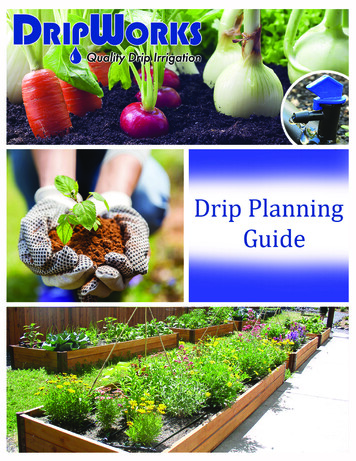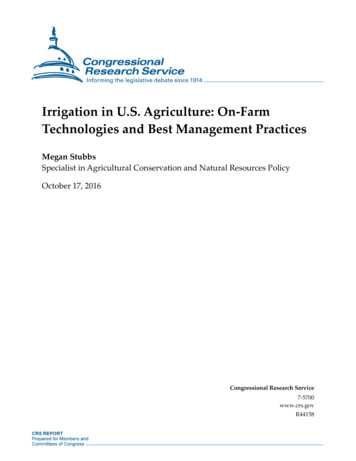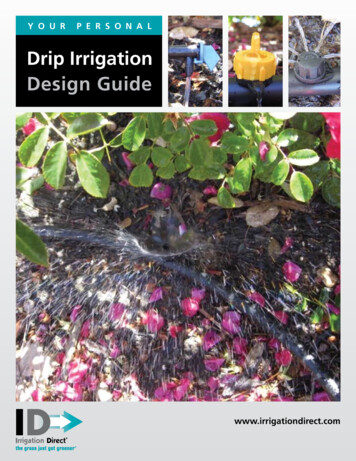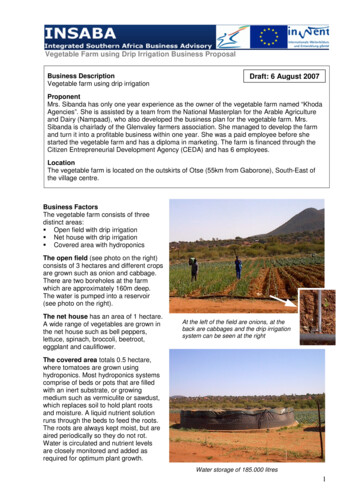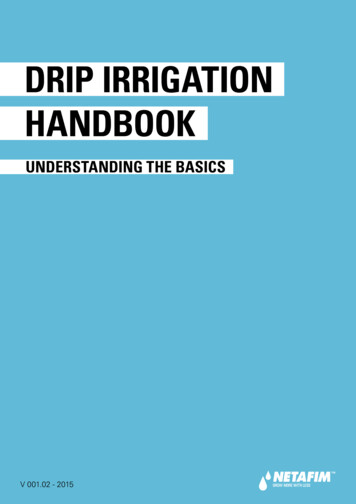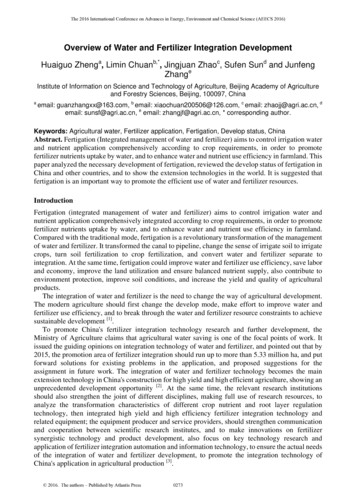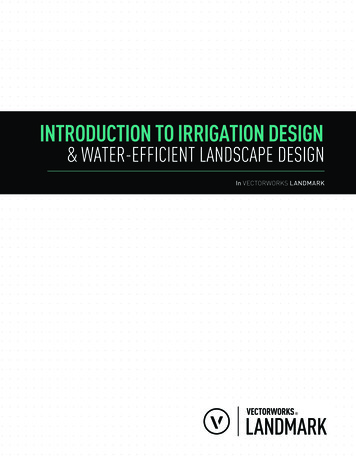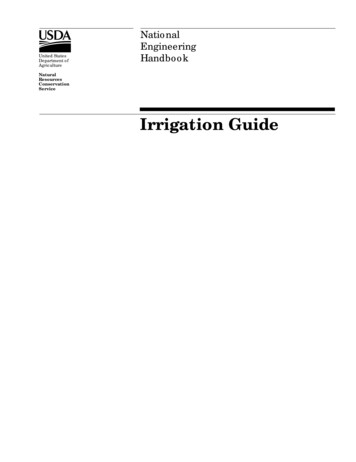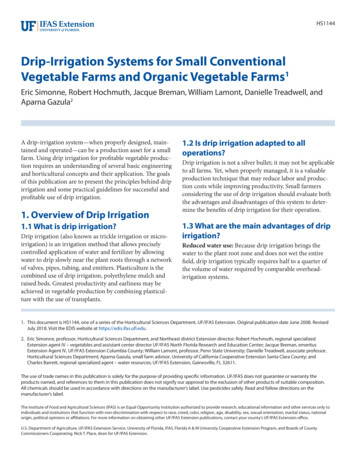
Transcription
HS1144Drip-Irrigation Systems for Small ConventionalVegetable Farms and Organic Vegetable Farms1Eric Simonne, Robert Hochmuth, Jacque Breman, William Lamont, Danielle Treadwell, andAparna Gazula2A drip-irrigation system—when properly designed, maintained and operated—can be a production asset for a smallfarm. Using drip irrigation for profitable vegetable production requires an understanding of several basic engineeringand horticultural concepts and their application. The goalsof this publication are to present the principles behind dripirrigation and some practical guidelines for successful andprofitable use of drip irrigation.1. Overview of Drip Irrigation1.1 What is drip irrigation?Drip irrigation (also known as trickle irrigation or microirrigation) is an irrigation method that allows preciselycontrolled application of water and fertilizer by allowingwater to drip slowly near the plant roots through a networkof valves, pipes, tubing, and emitters. Plasticulture is thecombined use of drip irrigation, polyethylene mulch andraised beds. Greatest productivity and earliness may beachieved in vegetable production by combining plasticulture with the use of transplants.1.2 Is drip irrigation adapted to alloperations?Drip irrigation is not a silver bullet; it may not be applicableto all farms. Yet, when properly managed, it is a valuableproduction technique that may reduce labor and production costs while improving productivity. Small farmersconsidering the use of drip irrigation should evaluate boththe advantages and disadvantages of this system to determine the benefits of drip irrigation for their operation.1.3 What are the main advantages of dripirrigation?Reduced water use: Because drip irrigation brings thewater to the plant root zone and does not wet the entirefield, drip irrigation typically requires half to a quarter ofthe volume of water required by comparable overheadirrigation systems.1. This document is HS1144, one of a series of the Horticultural Sciences Department, UF/IFAS Extension. Original publication date June 2008. RevisedJuly 2018. Visit the EDIS website at https://edis.ifas.ufl.edu.2. Eric Simonne, professor, Horticultural Sciences Department, and Northeast district Extension director; Robert Hochmuth, regional specializedExtension agent IV – vegetables and assistant center director UF/IFAS North Florida Research and Education Center; Jacque Breman, emeritusExtension Agent IV, UF/IFAS Extension Columbia County; William Lamont, professor, Penn State University; Danielle Treadwell, associate professor,Horticultural Sciences Department; Aparna Gazula, small farm advisor, University of California Cooperative Extension Santa Clara County; andCharles Barrett, regional specialized agent – water resources; UF/IFAS Extension, Gainesville, FL 32611.The use of trade names in this publication is solely for the purpose of providing specific information. UF/IFAS does not guarantee or warranty theproducts named, and references to them in this publication does not signify our approval to the exclusion of other products of suitable composition.All chemicals should be used in accordance with directions on the manufacturer’s label. Use pesticides safely. Read and follow directions on themanufacturer’s label.The Institute of Food and Agricultural Sciences (IFAS) is an Equal Opportunity Institution authorized to provide research, educational information and other services only toindividuals and institutions that function with non-discrimination with respect to race, creed, color, religion, age, disability, sex, sexual orientation, marital status, nationalorigin, political opinions or affiliations. For more information on obtaining other UF/IFAS Extension publications, contact your county’s UF/IFAS Extension office.U.S. Department of Agriculture, UF/IFAS Extension Service, University of Florida, IFAS, Florida A & M University Cooperative Extension Program, and Boards of CountyCommissioners Cooperating. Nick T. Place, dean for UF/IFAS Extension.
Joint management of irrigation and fertilization: Dripirrigation can improve the efficiency of both water andfertilizer. Precise application of nutrients is possible usingdrip irrigation. Hence, fertilizer costs and soluble nutrientlosses may be reduced with drip irrigation. Nutrientapplications may also be better timed to meet plant needs.Reduced pest problems: Weed and disease problemsmay be reduced because drip irrigation does not wet therow middles or the foliage of the crops as does overheadirrigation.Simplicity: Polyvinyl chloride (PVC) and polyethyleneparts are widely available in several diameters and are easyto assemble. Many customized, easy-to-install connectors,endcaps, and couplers are available in different diameters.Cutting and gluing allows for timely repairs.Drip irrigation requires maintenance and high-qualitywater: Once emitters are clogged or the tape is damaged,the tape must be replaced. Water dripping from an emitterand the subsequent wetting pattern are hard to see, whichmakes it difficult to know if the system is working properly.Proper management of drip irrigation requires a learningperiod.Water-application pattern must match planting pattern:If emitter spacing (too far apart) does not match theplanting pattern, root development may be restricted and/or plants may die.Safety: Drip tubing may be lifted by wind or may bedisplaced by animals unless the drip tape is covered withmulch, fastened with wire anchor pins, or lightly coveredwith soil.Low pumping needs: Drip systems require low operatingpressure (20–25 psi at field entrance, 10–12 psi at the driptape) compared to overhead systems (50–80 psi). Manyexisting small pumps and wells may be used to adequatelyirrigate small acreage using drip systems.Leak repair: Drip lines can be easily cut or damaged byother farming operations, such as tilling, transplanting, ormanual weeding with a hoe. Damage to drip tape causedby insects, rodents, or birds may create large leaks that alsorequire repair.Automation: Drip-irrigation application may be simplymanaged and programmed with an AC- or battery-poweredcontroller, thereby reducing labor cost.Drip-tape disposal causes extra cleanup costs afterharvest: Planning is needed for drip-tape disposal, recycling, or reuse.Adaptation: Drip systems are adaptable to oddly shapedfields or those with uneven topography or soil texture,thereby eliminating the underutilized or non-croppedcorners and maximizing the use of available land.1.5 How does my drip-irrigation systemaffect organic certification?Production advantages: Combined with raised beds,polyethylene mulch, and transplants, drip irrigationenhances earliness and crop uniformity. Using polyethylenemulch also increases the cleanliness of harvested productsand reduces the risk of contamination with soil-bornpathogens. Reflective mulches further help reduce theincidence of viral diseases by affecting insect vectors, suchas thrips, whiteflies, or aphids.1.4 What are the disadvantages of dripirrigation?Drip irrigation requires an economic investment: Dripirrigation systems typically cost 500– 1,200 or more peracre (Table 1). Part of the cost is a capital investment usefulfor several years, and another part is due to the annual costof disposable parts. Growers new to drip irrigation shouldstart with a relatively simple system on a small acreagebefore moving to a larger system.Growers considering certified organic production shouldfirst become familiar with the National Organic Program(NOP) (http://www.ams.usda.gov/NOP/indexIE.htm) andthe principles of organic production (Ferguson, 2004a,b;Treadwell, 2006). All production inputs used in certifiedorganic production must follow the National List of Allowed and Prohibited Substances (Code of Federal Register[CFR] 205.600 of the National Organic Program). Dripirrigation itself (standard drip tape) is allowed. Productstypically used with drip irrigation in conventional production systems that may or may not be allowed in certifiedorganic production may be classified in four groups: water,products for drip-irrigation maintenance (algaecides,disinfectants and acids), fertilizers, and pesticides (Table 2).The design and maintenance of a drip-irrigation systemshould be clearly outlined in the Organic System Plan (farmplan required for certification), including any inputs thatwill be delivered through the drip-irrigation system. In allcases, contact your certifying agency before using a productDrip-Irrigation Systems for Small Conventional Vegetable Farms and Organic Vegetable Farms2
to confirm that use of that product will not jeopardizeorganic certification.Drip-irrigation water. In most cases, groundwater, surfacewater, rainwater, and potable water may be used in certifiedorganic production. In some instances, the certifyingagency may request a water analysis.Products for drip-irrigation maintenance. Within statedrestrictions (see Table 2), CFR 205.601 of the NOP lists thefollowing substances as allowable as synthetic algaecide,disinfectant, and sanitizers: (1) alcohols, including (a)ethanol and (b) isopropanol; (2) chlorine materials [exceptthat residual chlorine levels in the water shall not exceedthe maximum residual disinfectant limit under the SafeDrinking Water Act], including (a) calcium hypochlorite,(b) chloride dioxide, (c) sodium hypochlorite; (3) hydrogenperoxide; and (4) soap-based algaecide/demisters. Additionally, under NOP Rule CFR 205.105, citric acid isallowed when irrigation water needs to be acidified. (SeeSection 4.2 of this paper for why and how much.) However,other compounds commonly found in ready-to-use dripirrigation cleaners and maintenance products and typicallyused in conventional systems (see Section 4.2, below) areprohibited in certified organic production.Fertilizers and pesticides. No specific ruling prohibitsNOP-compliant products from being distributed througha drip-irrigation system. Plans to use drip irrigation todistribute fertilizers and/or pesticides should be clearlyoutlined for approval in the Organic System Plan. When indoubt, consult first with your certifying agency. All growersare obligated to follow state and federal guidelines forinjecting inputs through irrigation systems (see Section 2).1.6 Is drip irrigation considered a BestManagement Practice?Yes. Best Management Practices (BMPs) are culturalpractices that help reduce the environmental impact of production while maintaining or increasing productivity. TheBMP program for vegetables grown in Florida is describedin “Water quality/quantity best management practices forFlorida vegetable and agronomic crops” (Florida Department of Agriculture and Consumer Services, 2005). TheBMP manual describes all the BMPs that apply to vegetableproduction, as well as a decision-tree to identify the BMPsthat apply to each operation and guidelines for completingand submitting the Notice of Intent to Implement (Gazulaet al., 2007).Participation in the Florida BMP program and the organiccertification program are two separate processes. Vegetablegrowers who are enrolled in the statewide BMP programreceive three statutory benefits: (1) a waiver of liability fromreimbursement of cost and damages associated with theevaluation, assessment, or remediation of nitrate contamination of groundwater (Florida Statutes [F.S.] 376.307); (2)a presumption of compliance with water-quality standards(F.S. 403.067 (7)(d)), and (3) eligibility for cost-shareprograms (F.S. 570.085 (1)).Specific vegetable BMPs that address drip irrigationinclude BMP 33 “Optimum fertilization application/management”, BMP 34 “Chemigation /fertigation”, BMP 39“Irrigation system maintenance and evaluation”, and BMP47 “Plasticulture farming”. Additional BMPs involving dripirrigation include BMP 26 “Soil testing/soil pH”, BMP 36“Water supply” and BMP 40 “Irrigation scheduling”. BMPimplementation requires record keeping (see Table 3).When properly implemented, all BMPs that apply to dripirrigation help to increase efficiency in the use of water andnutrients.1.7 What is the best way (or best unit)to express irrigation rates when dripirrigation is used?For irrigation systems that entirely wet the field (overheador flood systems), irrigation rates are typically expressedin inches. This unit of measurement represents a verticalamount of water (or a height). The actual “volume” of wateris calculated by multiplying the height of water by the fieldsurface. For example, 1 acre inch is the volume of waterpresent on a 1-acre field with a 1-inch depth: 1 acre inch 27,154 gallons.Because drip irrigation does not wet the entire field, expressing drip-irrigation volumes as a height of water poorlyrepresents reality. Instead, drip-irrigation volumes shouldbe expressed in gallons-per-100-linear-foot-of-drip-tape.In some cases, drip-irrigation volumes can be converted toand from water heights by considering the relative surfaceof the field under plastic mulch. For example, the relativesurface under plastic mulch of a 1-acre field with 30-inchwide beds of 4-ft centers is 62.5% (2.5 ft/4 x 100). Hence,if 0.5 acre inch needs to be applied to that field through adrip-irrigation system, the total volume of water needed is8,484 gallons (27,150 / 2 x 0.625). Because in a 1-acre fieldwith beds of 4-ft centers there are 10,890 linear-bed-feetof plastic, the drip-irrigation rate should be reportedas 78 gallons/100 ft (8,484/108.90). If a drip tape with aDrip-Irrigation Systems for Small Conventional Vegetable Farms and Organic Vegetable Farms3
24-gal/100-ft/hr flow rate is used, it will take 3 hours and 15minutes to apply this amount of water (78/3 3.25 hrs).In heavy soil, it is reasonable to assume that a drip tapeinstalled in the middle of the bed will be sufficient to wetthe entire bed width. However, research has shown that, onFlorida’s sandy soils, the wetted width seldom exceeds 18inches (1.5 ft) when a single drip tape is used. Hence, theassumption made in the calculation above—that the entirebed width is wetted (and, therefore, irrigated)—is not correct for most drip-irrigation systems in Florida. The actualwetted width should be used in place of the bed width.2. Components of a Drip-IrrigationSystemThe type and sequence of components in a drip-irrigationsystem are typically the same for all field sizes. Yet, basedon field size (and water need), component sizes (diameter)may vary. Larger components tend to be more expensive.The backflow-prevention devices—comprised of twocheck valves and the lowpressure drain, also known as“anti-siphoning device”—are the only components requiredby Florida law (FS 487.021 and 487.055 and Florida Department of Agriculture and Consumer Services Rule 5E-2.030)when fertilizer or chemicals are injected into the system(see Section 2.6, below). The actual selection of a specificcomponent (with the exception of the backflow-preventiondevice) generally needs to be made on a case-by-case basis.(See Table 11 for additional readings on this topic.) Thefollowing is a brief description of the main components of atypical drip-irrigation system.2.1 Water SourceCommon water sources for drip irrigation are surface water(pond, river, and creek), groundwater, and potable water(from municipality, county, or utility company) (Figure 1).Use the water source that will provide the largest amount ofwater of greatest quality and lowest cost. Potable water is ofhigh, constant quality, but is by far the most expensive.2.2 Pumping SystemThe role of the pumping system is to move water from thewater source to the field through the distribution system.Pumping systems may be classified as electric poweredsystems, gas/diesel powered systems, and gravity systems.Gas/diesel pumps offer the greatest versatility in isolatedfields (Figure 2).Figure 1. This pond provides surface water for the irrigation ofstrawberry.Credits: Eric Simonne.Figure 2. Diesel engines mounted on a trailer offer the greatestflexibility of use.Credits: Eric Simonne.2.3 Distribution SystemThe role of the distribution system is to convey the waterfrom the source to the field. Distribution systems may beabove ground (easily movable) or underground (less likelyto be damaged). Pipes are most commonly made of PVC orpolyethylene plastics. Aluminum pipes are also available,but are more difficult to customize, cut, and repair. The sizeand shape of the distribution system may vary widely fromfield to field and from farm to farm.2.4 Drip Tape (or Drip Tube)The drip-irrigation system delivers water to each plantthrough a thin polyethylene tape (or tube) with regularlyspaced small holes, called emitters. Selection of drip tapeshould be based on emitter spacing and flow rate. The typical emitter spacing for vegetables is 12 inches, but 8 inchesDrip-Irrigation Systems for Small Conventional Vegetable Farms and Organic Vegetable Farms4
or 4 inches may be acceptable. Dry sections of soil maydevelop between consecutive emitters when a wider emitterspacing (18 inches) is used on sandy soils. Flow rates areclassified into low flow ( 20 gal/100 ft/hr), medium flow(20 to 30 gal/100 ft/hr) and high flow ( 30 gal/100 ft/hr).The risk of emitter clogging is generally higher with thelower-flow drip tapes.The following equivalent units are commonly used to reportflow rates: gal/100 ft/hr or gallons/emitter/hr. For example,with a 12-inch emitter spacing, 24 gal/100 ft/hr 24/100 0.24 gal/emitter/hr. In the field, drip-irrigation tape shouldbe installed with emitters upward (looking up) to preventclogging from sediment deposits settling in the emittersbetween irrigation events. Drip tapes are widely availablefrom several manufacturersFigure 3. Drip tapes can be distinguished and recognized by theirfeatures. Note the emitter (on the four tapes on the right) and theturbulent flow channels (on the two tapes on the left).Credits: Eric Simonne.Figure 4. Back-flow prevention made of two ball valves and a vacuumbreaker are placed upstream of the Venturi injector.Credits: Eric Simonne.2.5 InjectorsFigure 5. Injection made possible with a Dosatron.Credits: Eric Simonne.Injectors allow the introduction of fertilizer, chemicals, andmaintenance products into the irrigation system. Floridalaw requires the use of an anti-siphoning device (also calledbackflow-prevention device) when fertilizer, chemicals,or any other products are injected into a drip-irrigationsystem (Figure 4). Backflow-prevention devices ensure thewater always moves from the water source to the field. Thedevices prevent chemicals in the water from polluting thewater source.2.6 Filtration SystemThe most common injectors used with small drip-irrigationsystems are the Venturi (or Mazzei) injector (Figure 4) andthe Dosatron (Figure 5). Because Venturi injectors involveno moving parts and are less expensive, they are commonlyused on small farms (Table 2). The injector is typicallylocated as close as possible to the irrigation zone, but beforethe filter.Because drip-irrigation water must pass through the emitters, the size of the particles in the water must be smallerthan the size of the emitter to prevent clogging. Nearly allmanufacturers of drip-irrigation equipment recommendthat filters be used. The manufacturer generally will nothonor warranties unless filters are used.The filtration system removes “large” solid particles insuspension in the water. Different types of filters are usedbased on the type of particles in the water. Media filters(often containing angular sand) are used with surface waterwhen large amounts of organic matter (live or dead) need tobe filtered out. Screen filters or disk filters may be used withgroundwater (Figure 6). A 200-mesh screen or equivalentis considered adequate for drip irrigation. When the watercontains sand, a sand separator should be used.Drip-Irrigation Systems for Small Conventional Vegetable Farms and Organic Vegetable Farms5
2.7 System ControlsSystem controls are devices that allow the user to monitorhow the drip-irrigation system performs. These controlshelp ensure the desired amount of water is applied to thecrop throughout the growing season.Pressure regulators, installed in-line with the system, regulate water pressure at a given water flow (Figure 7), therebyhelping to protect system components against damagingsurges in water pressure. Pressure surges may occur whenthe water in the pipe has a velocity 5 feet /second (“waterhammer”) or when water flowing in the pipe has no avenuefor release due to a closed valve or a clog in the pipe.Figure 6. Disk filters are made of stacked disks with small openings.They are usually color coded to indicate the filtration mesh.Credits: Eric Simonne.Rapid clogging may occur when no filter or the incorrecttype of filter is used. A filter needs to be cleaned when thedifference in pressure across the filter (measured beforeand after the filter) is greater than 5–8 psi. A drip-irrigationsystem should never be operated without a filter even if thefilter requires frequent cleaning. Failure to use a filter willresult in clogged drip-tape emitters, often resulting in pooruniformity and sometimes in crop loss. The filter shouldbe cleaned as often as needed. Efforts should be made tounderstand the cause of the rapid clogging, and remediation for the problem should be developed.The presence of the filter after the point of fertilizerinjection means totally soluble fertilizers must be used.Otherwise fertilizer particles may contribute to filterclogging. Conventional growers may use two types offertilizer materials: ready-to-use true solutions or dissolvedgranular fertilizer. Ready-to-use solutions are easilyinjected. However, granular fertilizers are sometimes coatedwith a thin layer of oil to prevent dusting. Upon dissolutionof the fertilizer granules, an oily film may form at thesurface of the solution. Injecting the oily film together withthe fertilizer may contribute to filter and emitter clogging.Certified organic fertilizers are seldom true solutions (theymay be suspensions or dilute colloidal solutions), andmay also contribute to filter clogging. Consequently, theactual fertilizer rate applied may be reduced by the amountof fertilizer particles trapped by the filter. In both cases,small-scale trials may be needed to assess the clogging riskof each fertilizer material used.Figure 7. Pressure regulators are installed side-by-side in this systemto allow a greater flow rate. Note the small injection port for chemicalinjection.Credits: Eric Simonne.Water meters monitor and record the amount of watermoving through a pipe where the water meter is installed(Figure 8). When a stopwatch is used together with a watermeter, it is possible to determine the water flow in thesystem in terms of gallons-per-minute.Figure 8. Water meters installed near the field.Credits: Eric Simonne.Drip-Irrigation Systems for Small Conventional Vegetable Farms and Organic Vegetable Farms6
Pressure gauges monitor water pressure in the systemand ensure operating pressure remains close to therecommended or benchmark values. Based on where thepressure gauge is installed, it will measure water pressurein a various ranges, from 0–100 psi near the pump to 0–20psi at the end of drip tape (Figure 9). Pressure gauges maybe installed at set points (near the pump, before and afterthe filter, near the field; see Figure 10). They can also bemounted as portable devices and installed temporarily atthe end of a drip tape.12 centibars 6 inches away from the drip tape and at the12-inch depth.Electrical timers connected to solenoid valves (Figure11) may be used to automatically operate a drip-irrigationsystem at pre-set starting and ending operating times ofday.Figure 11. Solenoid valves connected to a timer allow sequentialirrigation of different zones.Credits: Eric Simonne.3. Tips for Design and LayoutFigure 9. A portable pressure gauge measures pressure at the end ofthe drip tape.Credits: Eric Simonne.Irrigation engineers are trained and certified to properlydesign drip-irrigation systems. Relying on their expertisewill pay off in the long run. Many small-scale growersabandon drip irrigation because of poor performance offlawed designs or inadequately modified designs. Do nothesitate to ask for professional help when designing yourdrip-irrigation system or when planning major modifications to an existing system. The following section presentsthe basics of system design, but is not a substitute for theprofessional services of a qualified engineer.3.1 Planning a Drip Irrigation System:Horticultural ConsiderationsFigure 10. A fixed pressure gauge. Note the needle bathing in oil toprevent needle vibration and damage.Credits: Eric Simonne.Soil-moisture-measuring devices (such as tensiometers,capacitance probes, or Time Domain Reflectometry probes)are used to measure soil moisture in the root zone of thecrop (Muñoz-Carpena 2004). The Florida Extension Servicerecommends maintaining soil-water tension between 8 andThe goal of drip irrigation is to bring water to the crop. Themain parameters that determine crop water use are the typeof crop planted and row spacing. A drip irrigation systemshould be able to supply 110%–120% of crop water needs.In other words, the system should be slightly oversized.In designing a drip-irrigation system, it is common toconsider that vegetable crops ordinarily need approximately1.5-acre-inches of water for each week of growth or approximately 20-acre-inches of water per crop. Actual cropwater use will be more or less than this amount, dependingon weather and irrigation efficiency.Drip-Irrigation Systems for Small Conventional Vegetable Farms and Organic Vegetable Farms7
3.2 Planning a Drip Irrigation System:Design Considerationsbe irrigated with different pipe sizes at a water velocity of 5feet/second (Table 6).Start with what is already available—the water source or thefield. If a water source is already available (pond or well),the amount of water available may be used to calculate themaximum size of each irrigation zone (Table 4).The maximum length of drip tape should be based on themanufacturer’s recommendation and the actual terrainslope. Typically 400–600 feet are maximum values for driptape length. Excessive length of laterals will result in pooruniformity and uneven water application. When the field islonger than 400–600 feet, consider placing the secondary(submain) line in the middle of the field—rather than at theend—and connect drip tape on both sides.If no water source is available, the amount of water neededby the crop—based on the size of the planted area—may beused to calculate the type of well or pond size needed (Table5).Lay out of beds and rows. Because differences in altitudesaffect water pressure, it is preferable to lay out beds perpendicular to the slope. This arrangement of rows is called“contour farming” (Figure 12).3.3 Layout TipsA Y-connector is convenient on a drip system connected toa hose bibb because a garden hose can be connected to theother side.To evaluate source flow rate, run water full force from anoutside faucet and note the number of seconds required tofill a bucket of known volume. Calculate the gallons of flowper hour (gph) by dividing the bucket size in gallons by thenumber of seconds required to fill it, then multiply by 3600seconds for gallons-per-hour:System flow rate (in gph) Bucket volume (in gallons) /time needed to fill (in seconds) x 3,600 seconds per hourFigure 12. In contour farming, rows are laid perpendicularly to thenatural field slope, which allows each drip tape to be parallel to eachother and contour (The drip tape is laid horizontally).Credits: Eric Simonne.Pipe sizing. Larger-diameter pipes are more expensive thansmaller-diameter pipes, but larger-diameter pipes carrymore water. All delivery mains and secondary lines shouldbe sized to avoid excessive pressure losses and velocities andshould be able to withstand a pressure of 80 psi.Excessive pressure losses result in a large difference inpressure from the pressure level at the beginning of the linecompared to the pressure level at the end of the line. Sincethe flow rate of the emitters is usually a function of waterpressure, the water application at the beginning of the linemay be very different from the water application at theend of the line. This difference will result in irregular waterapplication on the crop.Excessive water velocities ( 5 ft/sec) in the lines—the resultof a too-small diameter—are likely to create a water hammer (pressure wave), which can damage the delivery lines.Growers should be aware of the maximum acreage that canThe maximum flow is considered to be 75% of the flow-ratemeasure above. Maximum flow is the largest number ofgallons available for use at one time while operating adrip-irrigation zone.Use goof plugs to plug holes in the mainline that are nolonger needed due to system modification.Common setup mistakes include not installing a filter or apressure reducer, using excessively high lengths of mainline,and/or adding too many drip emitters.Zones should be approximately the same size throughoutyour drip-irrigation system. Variation in zone sizes willreduce the efficiency of pump operation. When all zones areof the same size, pipe sizes and system cost will normally beminimal. The length of the mainline should not exceed 200feet in a single zone.Pressure regulators may be required if the pressureproduced by the pump is too large or if zones vary greatlyin size. If the pump was sized for a previously existingsprinkler system, it would likely operate at pressures thatare excessive for the components of a drip system. If thesystem consists of different size zones, the pump mustDrip-Irrigation Systems for Small Conventional Vegetable Farms and Organic Vegetable Farms8
deliver the amount of water required in the largest zone atthe pressure required by the tape used for lateral lines. Ifsome zones are significantly smaller, the pump will producehigher pressure at
The design and maintenance of a drip-irrigation system should be clearly outlined in the Organic System Plan (farm plan required for certification), including any inputs that will be delivered through the drip-irrigation system. In all cases, contact your certifying agency before using a product
